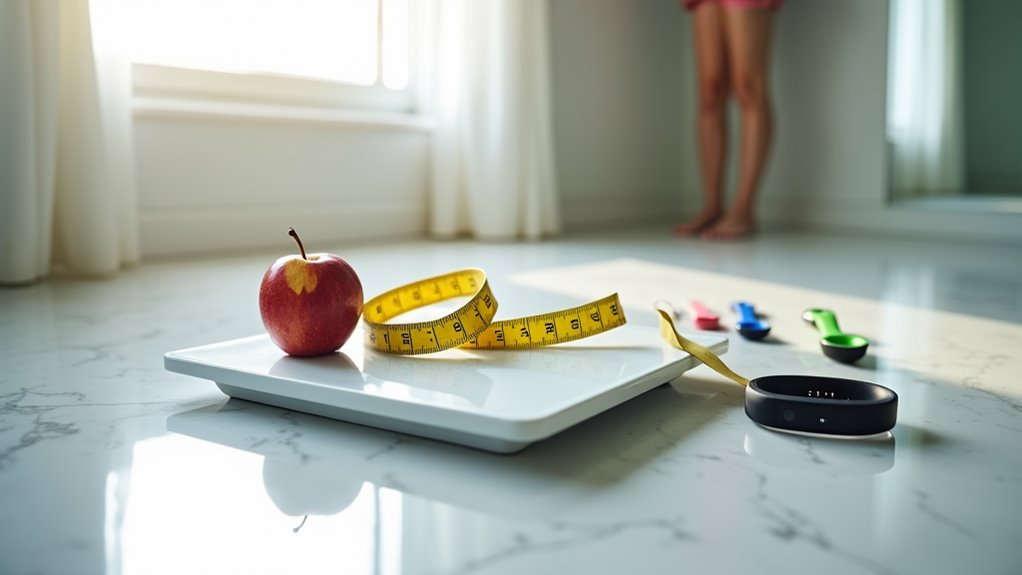Why Your Scale Lies – And What to Do Instead!
You’ve probably experienced the frustration of stepping on your scale, only to see a number that doesn’t match your efforts. Whether you’ve been sticking to your nutrition plan or crushing your workouts, those digital digits can swing wildly from day to day. What you’re seeing isn’t always the truth about your progress – it’s often a misleading snapshot affected by multiple hidden factors. Understanding why your scale lies will transform how you track your fitness journey.
The Science Behind Daily Weight Fluctuations
Although your bathroom scale provides a single number each morning, that figure represents far more than just your body fat and muscle mass.
When you’re wondering why your scale lies, it’s essential to understand the various factors affecting that number throughout the day.
Your body weight naturally fluctuates by 2-5 pounds daily due to water retention, undigested food, and glycogen stores.
After eating a salty meal, your body holds onto more water to maintain proper sodium balance. Similarly, carbohydrate consumption causes your muscles to store glycogen, which binds to water molecules and temporarily increases your weight.
Even your hormone levels influence these daily shifts. For women especially, menstrual cycles can cause water retention that makes the scale jump several pounds. Additionally, lack of sleep can disrupt hormonal balance and lead to increased hunger, further complicating weight management.
That’s why it’s crucial to focus on weekly trends rather than getting discouraged by day-to-day changes that don’t reflect your true progress.
Common Factors That Make Your Scale Deceive You
While most people trust their bathroom scale as the ultimate measure of weight loss success, several common factors can lead to misleading readings. Your scale might show higher numbers if you’ve recently eaten a salty meal, finished an intense workout, or consumed more carbohydrates than usual.
Even the time of day you weigh yourself can impact the results. You’re not alone in feeling frustrated when the numbers don’t reflect your efforts. Women often see weight fluctuations during their menstrual cycle, while both men and women might notice higher readings after air travel or during humid weather.
The type of flooring your scale sits on matters too – an uneven surface or carpeting can throw off measurements significantly. To get more accurate readings, weigh yourself at the same time each day, preferably first thing in the morning after using the bathroom, and always place your scale on a hard, flat surface. Additionally, factors like sleep deprivation’s impact on hunger hormones can lead to fluctuations in weight due to increased cravings and poor dietary choices.
Better Ways to Measure Your Fitness Progress
So how can you track your fitness journey beyond the numbers on your scale? Start by taking progress photos every two weeks, wearing the same clothes in consistent lighting. You’ll notice changes that the scale won’t reveal, especially as you build muscle and lose fat.
Track how your clothes fit – that favorite pair of jeans can tell you more about your progress than any number.
Keep a fitness journal to record your increasing strength, endurance, and energy levels. You’ll love seeing how many more push-ups you can do or how much faster you can run.
Measure your body composition using calipers or specialized scans, and take monthly measurements of your waist, hips, and other key areas.
Focus on your daily habits too – record your water intake, sleep quality, and how you feel during workouts. These markers paint a more complete picture of your improving health and fitness level. Additionally, managing your stress levels can significantly enhance your overall fitness journey and help you achieve your goals more effectively.
Understanding Body Composition vs. Total Weight
The number you see on your scale doesn’t tell the whole story about your body’s makeup. Your total weight is simply the sum of everything in your body – including muscle, fat, bones, organs, and water.
Two people can weigh exactly the same but look completely different because of their body composition.
Body composition refers to the ratio of fat mass to lean mass in your body. Lean mass includes your muscles, organs, and bones, while fat mass is the amount of fat tissue you’re carrying.
When you’re working on your fitness goals, you’ll want to focus on improving this ratio rather than just watching the scale move up or down. That’s why many fitness enthusiasts track their body fat percentage, take progress photos, or measure inches lost instead.
These methods give you a much clearer picture of how your body is actually changing and help you stay motivated on your fitness journey. Additionally, maintaining a caloric deficit is essential for effective weight loss, regardless of how the scale reads.
Creating a Balanced Tracking System for Success
Because tracking your progress shouldn’t feel like an obsession, it’s important to develop a balanced approach that combines multiple measurement methods. You’ll get a more accurate picture of your fitness journey when you gather data from different sources and track them at appropriate intervals. Maintaining a caloric deficit is essential for successful weight loss and should be considered alongside other metrics.
| Tracking Method | Recommended Frequency |
|---|---|
| Scale Weight | Weekly |
| Body Measurements | Bi-weekly |
| Progress Photos | Monthly |
| Strength Records | Every workout |
| Clothing Fit | As noticed |
Create a simple tracking system that works for your lifestyle. Use a fitness app or journal to log your measurements, and remember that fluctuations are normal. Focus on trends rather than daily changes, and celebrate non-scale victories like improved energy levels, better sleep, and increased strength. When you combine these different tracking methods, you’ll build a more complete understanding of your progress and maintain a healthier relationship with your fitness journey.
Building a Healthy Relationship With Weight Measurement
While many people view their scale as the ultimate measure of success, developing a healthy relationship with weight measurement requires understanding its limitations and context. Your weight naturally fluctuates throughout the day due to factors like hydration, food intake, and hormonal changes. These variations don’t reflect true changes in body composition.
Instead of daily weigh-ins, try measuring your weight weekly at the same time, preferably in the morning after using the bathroom. This gives you a more accurate trend over time.
Remember, you’re not defined by the number on the scale – it’s just one of many tools in your wellness journey.
Focus on how your clothes fit, your energy levels, and your strength gains. Take progress photos and measurements to track changes.
When you understand that the scale is just one piece of the puzzle, you’ll build a more balanced and sustainable approach to monitoring your health progress.

